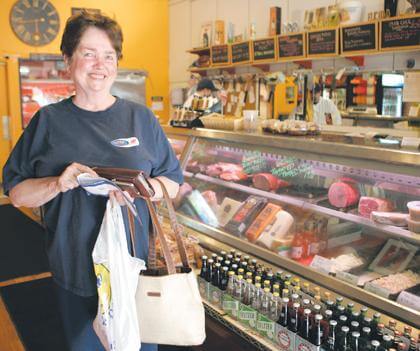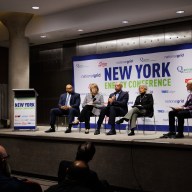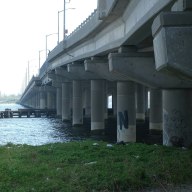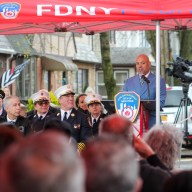By Philip Newman
New York City’s notorious cost of living is driving out thousands of the middle class in an exodus fueled not only by the exorbitance of Manhattan but Queens, too.
It turns out that of 315 urban areas in the United States, only Manhattan, San Francisco, Honolulu and San Jose are more expensive then Queens.
In fact, Queens is the fifth most−expensive urban area in the United States.
The Center for an Urban Future, a Manhattan think tank, reported that it takes $85,918 annually for a person to attain middle−class status in Queens, compared with $123,322 in Manhattan. The same lifestyle in Houston would require $50,000.
“Is it really that important to worry about the possible decline of New York’s middle class when the city has added so many well−heeled residents in recent years?” the center asked.
“The middle class are the backbone of the city’s work force — the book editors, Web designers, lab technicians, architects, nurses, paralegals, actors, university professors, carpenters and bus drivers.”
The Rev. Edwin Reed, chief financial officer of the Greater Allen AME Cathedral of Jamaica, said “the middle class are the professional people that really make the city run.”
Citywide, a combination of steep housing costs, the highest taxes in the nation and the rising cost of everything from milk to auto insurance has driven thousands of New Yorkers to places like eastern Pennsylvania, the Atlanta suburbs and North Carolina.
Overwhelmingly, it is housing costs that have diminished the middle class throughout the city, with the average monthly rent citywide at $2,801, which is 53 percent higher than in San Francisco, the second most−expensive city, the center found.
Between 1999 and 2007, the median sale price for a single−family home in Queens rose by 147 percent. That was more than in any borough except Manhattan, where the price shot up by 209 percent. The median price went up 131 percent in the Bronx, 145 percent in Brooklyn and 142 percent in Staten Island.
Queens residents are paying heavily for housing. A recent survey reported that 49 percent of residents shell out as much as 48 percent of their income on housing.
As for stagnant wages, the Center for an Urban Future said real weekly wages — those adjusted for inflation — rose by a smaller amount in Queens than in any other borough between 1975 and 2007.
In Queens wages rose by 1.1 percent, compared to 1.7 percent in Brooklyn, 2.5 percent in Staten Island and 8.6 percent in the Bronx. Wages climbed by 96 percent in Manhattan over the same period.
Queens also had a greater percentage of workers in low−wage jobs than any other borough except the Bronx. The report said 34.4 percent of Queens workers over 18 were employed in low−wage jobs, as determined by the U.S. Population Reference Bureau.
Citywide, the percentage of workers in low−wage jobs was 21 percent. In a breakdown by borough, the Bronx was at 42.1 percent, Brooklyn 32.2 percent, Staten Island 22.5 percent and Manhattan 21.6 percent.
But it is not just low wages and exorbitant housing that are making living in the city a trial for the middle class. Nearly everything costs more:
• Auto insurance: The survey obtained rate quotes for a 37−year−old male driving a 2006 Toyota Corolla who had been in no accidents in the previous five years and had an excellent bill payment history. In Queens he would pay $1,250 compared with $450 in Atlanta and $610 in Washington, D.C.
• Milk: One gallon in the city costs $4.08 (the national average is $3.82)
• The city has the nation’s fourth−highest telephone rates
• Day care in the city costs at least $2,000 a month for one child
New Yorkers pay 50 percent more in taxes than people in any other major American city and city taxes are 90 percent higher than in any other U.S. city. The average property tax on a one−, two− or three−family home has gone up 87 percent since 2000.
“Queens has done worse than any other borough in recent years when it comes to people moving out of the city,” said Jonathan Bowles, director of the Center for an Urban Future.
Most of the migration out of Queens and the rest of the city took place in more prosperous times before the economic slump began in late 2007.
“Queens lost 51,177 residents in 2006 vs. 35,788 in 1993,” Bowles said. “Thus, domestic out−migration levels for Queens was a staggering 43 percent higher in 2006 than in 1993.”
Most middle−class residents cannot afford private schools, so many leave the city.
“People like to live where they feel they have access to a good education for their children,” said Cheryl Caddle, chairman of the Education Committee of the Cambria Heights Civic Association. “A lot of people believe the public schools in New York are subpar.”
Tanya Cruz of Community Board 13, which stretches from Glen Oaks to Queens Village, Laurelton and Rosedale said “our educational system is failing.”
The Center for an Urban Future said another factor making New York unattractive is unsatisfactory public transportation.
Many parts of Queens and Brooklyn have the longest commutes in the nation, and conditions en route are not always good.
“On a lot of bus lines, people are packed in there like sardines,” said Yvonne Reddick, district manager of Community Board 12, which represents Jamaica, Hollis and Springfield Gardens.
Olga Djam of Elmhurst said many commutes are too long. “If you’re commuting for an hour and a half, when are you going to spend time with your kids?” she asked.
The center offered recommendations to preserve the city’s middle class:
• develop a strategy to diversify the economy and support the growth of middle−income jobs
• stop neglecting the city’s community colleges (whose graduates earn 38 percent more than high school graduates)
• improve mass transit, particularly outside Manhattan
• increase housing for the middle class
• protect the character of neighborhoods
• rethink efforts to increase revenue from fees and fines, which have a particularly heavy impact on the middle class.
Reach contributing writer Philip Newman by e−mail at news@timesledger.com or phone at 718−229−0300, Ext. 136.






























